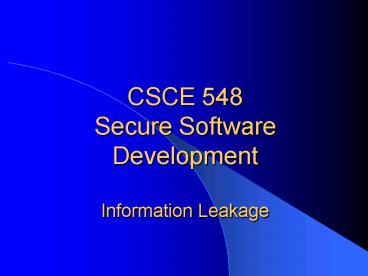CSCE 548 Secure Software Development Information Leakage PowerPoint PPT Presentation
1 / 30
Title: CSCE 548 Secure Software Development Information Leakage
1
CSCE 548 Secure Software DevelopmentInformation
Leakage
2
Reading
- For student presentation
- Howard et al. Chapter 4
- This lecture
- Howard et al. Chapter 13
- Recommended
- I. Moskowitz, M. H. Kang Covert Channels Here
to Stay? http//citeseer.nj.nec.com/cache/papers/c
s/1340/httpzSzzSzwww.itd.nrl.navy.milzSzITDzSz554
0zSzpublicationszSzCHACSzSz1994zSz1994moskowitz-co
mpass.pdf/moskowitz94covert.pdf - Jajodia, Meadows Inference Problems in
Multilevel Secure Database Management Systems
http//www.acsac.org/secshelf/book001/book001.html
, essay 24 - Next lecture
- Howard et al. Chapter 6
3
Information Leakage
- By accident
- By intention
4
Communication Channels
- Overt Channel designed into a system and
documented in the user's manual - Information leakage designers and developers DO
NOT understand security needs of the application - Covert Channel not documented. Covert channels
may be deliberately inserted into a system, but
most such channels are accidents of the system
design. - Information leakage slow information flow to
unauthorized recipient
5
Information Flow
- Direct Flow
- Bell-LaPadula example
- Indirect flow
- Covert channel
- Inference channel
TS-subject
TS-object
info- flow
info- flow
read
write
S-object
S-subject
6
Non-Interference
- High-security data does not influence lower
security data - How to guarantee it?
7
Covert Channel
- Timing Channel based on system times
- Storage channel not time related communication
- Can be turned into each other
8
Covert Channel
- Need
- Two active participants and encoding schema OR
- Access to the system and knowledge about the
system - Example sender modulates the CPU utilization
level with the data stream to be transmitted - Sender
- repeat get a bit to send
- if the bit is 1 wait one second (don't use CPU
time) - else busy wait one second (use CPU time)
- endif
- until done
9
Covert Channels
- Problems
- Noise
- Need sophisticated synchronization
- Protection (user state, system state)
- Removal
- Slow down
- Audit
10
Cryptographic Timing Attack
- How long does it take to perform encryption
- Table look ups
- Non-constant time
- Partial guesses ? faster performance
- Measure the duration between messages, where
message content depends on secret data
11
Inference Channels
Sensitive Information
- Non-sensitive
- information
Meta-data
12
Inference Channels
- Statistical Database Inferences
- General Purpose Database Inferences
13
Statistical Databases
- Goal provide aggregate information about groups
of individuals - E.g., average grade point of students
- Security risk specific information about a
particular individual - E.g., grade point of student John Smith
- Meta-data
- Working knowledge about the attributes
- Supplementary knowledge (not stored in database)
14
Types of Statistics
- Macro-statistics collections of related
statistics presented in 2-dimensional tables - Micro-statistics Individual data records used
for statistics after identifying information is
removed
15
Statistical Compromise
- Exact compromise find exact value of an
attribute of an individual (e.g., John Smiths
GPA is 3.8) - Partial compromise find an estimate of an
attribute value corresponding to an individual
(e.g., John Smiths GPA is between 3.5 and 4.0)
16
Methods of Attacks and Protection
- Small/Large Query Set Attack
- C characteristic formula that identifies groups
of individuals - If C identifies a single individual I, e.g.,
count(C) 1 - Find out existence of property
- If count(C and D)1 means I has property D
- If count(C and D)0 means I does not have D
- OR
- Find value of property
- Sum(C, D), gives value of D
17
Prevention
- Protection from small/large query set attack
query-set-size control - A query q(C) is permitted only if
- N-n ? C ? n , where n ? 0 is a parameter of
the database and N is all the records in the
database
18
Statistical Inference Theory
- Give unlimited number of statistics and correct
statistical answers, all statistical databases
can be compromised (Ullman)
19
Inferences in General-Purpose Databases
- Queries based on sensitive data
- Inference via database constraints
- Inferences via updates
20
Queries based on sensitive data
- Sensitive information is used in selection
condition but not returned to the user. - Example Salary secret, Name public
- ?Name?Salary25,000
- Protection apply query of database views at
different security levels
21
Database Constraints
- Integrity constraints
- Database dependencies
- Key integrity
22
Integrity Constraints
- CAB
- Apublic, Cpublic, and Bsecret
- B can be calculated from A and C, i.e., secret
information can be calculated from public data
23
Database Dependencies
- Metadata
- Functional dependencies
- Multi-valued dependencies
- Join dependencies
- etc.
24
Functional Dependency
- FD A ? B, that is for any two tuples in the
relation, if they have the same value for A, they
must have the same value for B. - Example FD Rank ? Salary
- Secret information Name and Salary together
- Query1 Name and Rank
- Query2 Rank and Salary
- Combine answers for query1 and 2 to reveal Name
and Salary together
25
Key integrity
- Every tuple in the relation have a unique key
- Users at different levels, see different versions
of the database - Users might attempt to update data that is not
visible for them
26
Example
Secret View
Public View
27
Updates
Public User
- Update Blacks address to Orlando
- Add new tuple (Red, 22,000, Manassas)
- If
- Refuse update covert channel
- Allow update
- Overwrite high data may be incorrect
- Create new tuple which data it correct
- (polyinstantiation) violate key constraints
28
Updates
Secret user
- Update Blacks salary to 45,000
- If
- Refuse update denial of service
- Allow update
- Overwrite low data covert channel
- Create new tuple which data it correct
- (polyinstantiation) violate key constraints
29
Inference Problem
- No general technique is available to solve the
problem - Need assurance of protection
- Hard to incorporate outside knowledge
30
Next Class
- Failing to handle errors

